My friends, this is the most basic play in the Oregon Spread Offense, and the first instructional video I created in the summer of 2011. Below we have the actual video, and below that is a text/screenshot explanation. (Note: in 2014 Oregon added a new variation of the Inside Zone Read and you can learn about it here. To learn about Zone Blocking for this play, go here, and for the Outside Zone Read play in the Oregon offense, go here. Enjoy them all! Charles Fischer
If you had no exposure to the Spread Offense in the past, how do you figure out what is occurring on the field? With the Spread….big holes would appear, but was that from the formation, unique blocking, or the direction we were attacking? Plays start one direction, but the ball ends up elsewhere on a routine basis and Chip is fine with it?
We just had a huge hole for a great TD in the UCLA game (below)….but how did it happen? Is there any consistency to the formations at all? It seemed we could end up ANYWHERE on the field no matter what the initial formation was. Normally in the offseason I like to do a little game action at no wagering casino sites in Canada, yet I also wanted to understand what Oregon was doing!
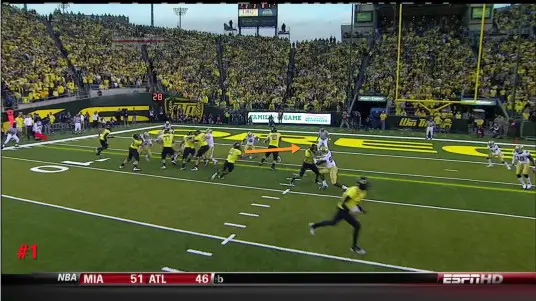
How did this play work so well against UCLA?
The Sportscasters on TV have been terrible. Frequently they say nothing because they are at a loss to explain what just happened. Kirk Herbstreet is the best of them in correctly identifying the Zone Read, but not he nor anyone else as of August of 2011 have explained the difference between the two basic plays that the Oregon Offense revolves around, the Inside and Outside Zone Read.
(Unfortunately he and others have also confused who was being Zone Read a number of times on telecasts) If we see an explanation on TV for the first time this fall after going into the seventh year of running this offense, then we know they finally went to FishDuck.com, or read Ducks Illustrated!
How did I learn this? I put in a ton of time watching games in slow-motion on my TiVo, but first I studied the presentation given by Coach Kelly to a Nike Coaches Clinic a few years ago. I have it on my website, but I got it off the Cal and USC websites as it has been available freely for years. It shows us the formations for the Inside and Outside Zone Reads as well as a ton of basics about the offense. The truth is….much of this is available about the Oregon Offense on numerous football and Spread Offense websites for coaches and fans as well. It’s not just the Xs and Os…it is the man running the team that makes Oregon Zone Read Spread Offense work so well.
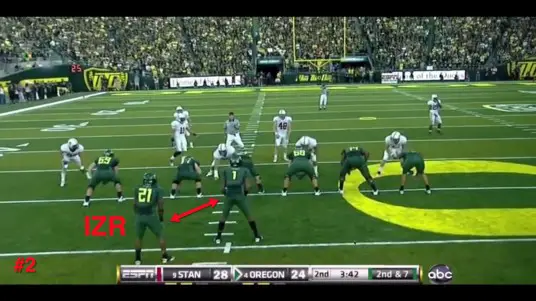
The formation in the backfield is one of two primary components that tell us whether it is an Inside Zone Read or Outside Zone Read….the two basic plays of the Oregon Offense. See how the RB is to the side and BEHIND the QB? (Above) That is an Inside Zone Read.
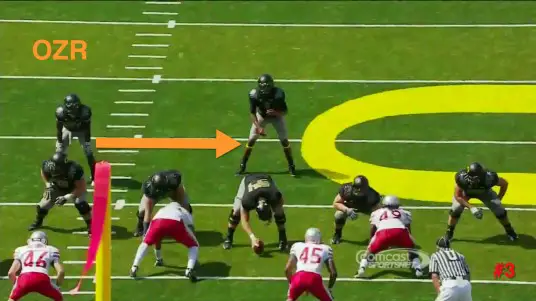
Now on the next image see how the RB is nearly straight to the SIDE of the QB? (Above) That is an OUTSIDE Zone Read. Every Defensive Coordinator and defensive player in the conference know these easy keys to focus upon and Chip Kelly is COUNTING on them learning this, and you’ll see why shortly.
The Inside Zone Read (IZR) is the foundation of the Oregon offense…and it is a tailback plunge play up the middle, or a dive play. It is physical blocking to create a hole, and is not meant to fool anyone as it is right up the gut. Everything starts with this play, and the complementary plays such as the Bubble Screen, the Play Action Pass, and the Triple Option…will not work if the two foundation plays (Inside & Outside Zone Read) don’t work. Success with the Outside Zone Read (OZR) depends on the threat of the IZR, thus it all starts right HERE with the Inside Zone Read.
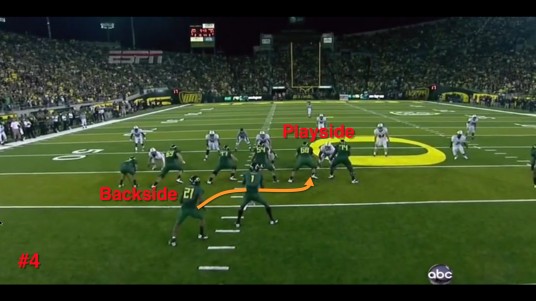
This is the darndest thing (above) you’re ever going to see….Chip ANNOUNCES the play in advance! The path of the orange line above shows where the play will go every time. You don’t see an IZR coming from an OZR formation and it’s been that way for six years. Look at the path of the play; it is intended to go between the guard and tackle…effectively an old Dive Play or RB plunge into the middle of the line! Oregon TELLS the opponent what we’re doing in advance by running the Inside Zone Read to the right when we’re in this formation. It’s like Vince Lombardi coaching the Jetsons….
Another primary element to the play is the backside Zone Read of the defensive end. Sometimes it is the defensive tackle, but that is another report. What is “Zone-Reading” a defender? It is what we used to call “optioning” a player. When Oregon ran the old option attacks, the Ducks would “option” a defensive end or tackle. Now the verbiage is “Zone Read” meaning whoever occupies that space or spot is being optioned or Zone Read. Oregon reacts to what he does.
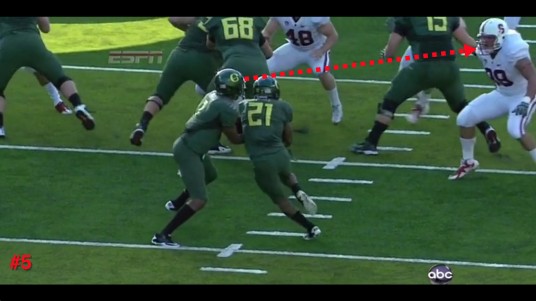
It is common that we Zone Read their best defensive lineman or Linebacker, thus we negate his effect on our offense. (Above) If the DE stays put or sits….then the RB is given the ball and runs toward the IZR hole, which is what Chip Kelly WANTS. He wants the ball with his RB, especially Oregon’s speedy running backs.
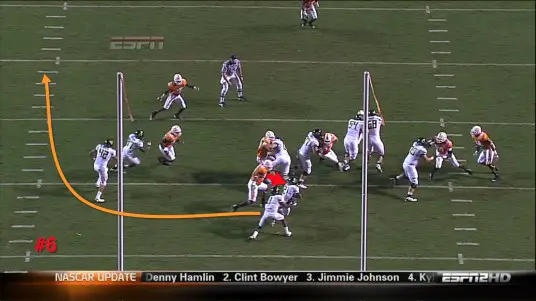
If the DE chases the RB, (Above) then the QB pulls the ball and runs through the gap from where the DE was. So it doesn’t matter where the DE goes…the ball ain’t here! As a defensive coordinator you don’t want the QB running down the backside of your defense and picking up big yards, thus most defenses will force the handoff to the RB by sitting in the gap.

So now you have stretched the defense out between the Zone Read on one side of the offense and a simple dive play on the other. (Above)
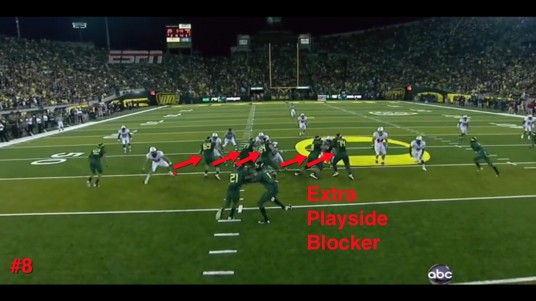
There is also something much more subtle that I believe is the primary reason for Oregon’s success running the ball since the spread was implemented. If the DE isn’t blocked on the backside of the play, the blocking responsibilities shift over from one player to another on the play side. This means Oregon picks up AN EXTRA BLOCKER ON THE PLAY SIDE….where the play is going. That is HUGE! If we can get everyone covered blocking, “hat-on-hat” as they call it, then it shoots our running game through the roof, which in my mind is the principal reason we became one the nation’s leading rushing teams.
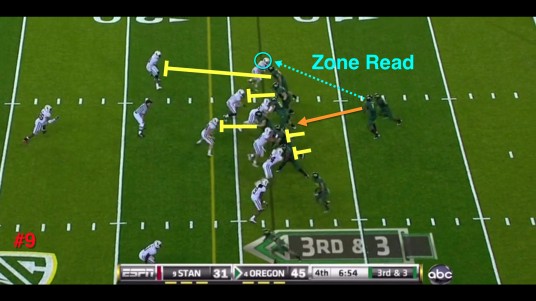
Notice how they block straight ahead (above) on most IZRs and that is another way you can tell it is an Inside Zone Read. Coach says that in this play, “we want to get off the ball, and be a physical, downhill-running football team. We want to come off the ball, create a double-team, knock the crap out of the defender, and deposit him in the LBs lap. This is physical football,” he says and we make over seven yards a carry on it in a typical year! On a dive play?! He states that we block five play side defenders on each play and after the defense commits to their scheme of attacking us on the play, we then identify the players we want to block through a simple system. Chip says, “if our guys can count to six, then we got a good chance of running the play.”
So how do you explain huge holes opening up in front Oregon’s RBs? Everyone says our line is too small, but then how did they open those holes and run for so much yardage? The talking heads on ESPN after the Stanford game were trying to say that, “well they’re running the veer offense on this particular play.”
Rin-Tin-Tin could see that we were not running the veer in that game. In the veer, the QB will option, or Zone Read the DT, and the DE, on the same side of the line of scrimmage on the same play. Were we doing that in the Stanford game? NO!
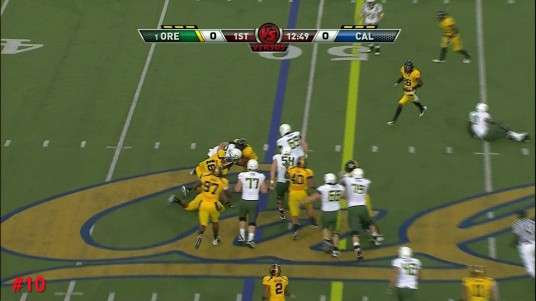
How do you stop the Oregon Offense? It is the same way as any other offense and it’s simple. Defeat the blocks. By announcing the play in advance with the formation–we experience more negative plays losing yardage than anyone else. (Above) Yet that element of the offense is what makes us one of the most explosive offenses in the nation!
A big reason for the success of the play is BECAUSE we announce it in advance with our IZR formation. Defenses over-react to where the play is going, and it creates huge gaps elsewhere. The RBs in this offense are to check the gap we are attacking, but take a quick look around; if another hole opens up elsewhere that is better—he has the green light to go for it!
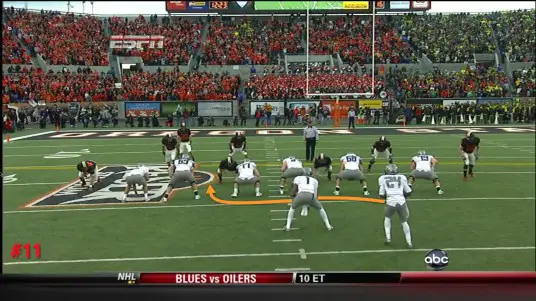
A great example of the over-reaction by a defense was in the fourth quarter of the Civil War game this year. We see (above) how we’re lined up to run the Inside Zone Read to the left at the beginning of the play, and the Beavers know it.
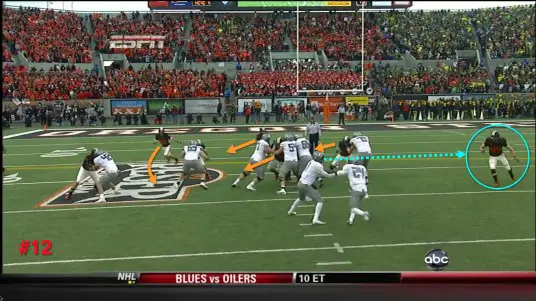
As the play starts, with just a second into it—we see Oregon State defenders move to our left, into the IZR gap that we’re attacking. They are becoming situated to plug it up. To the right is the DE who is unblocked and being Zone Read by Darron Thomas. Since the DE is “sitting”, then the correct read is to hand off, which what Thomas is doing.
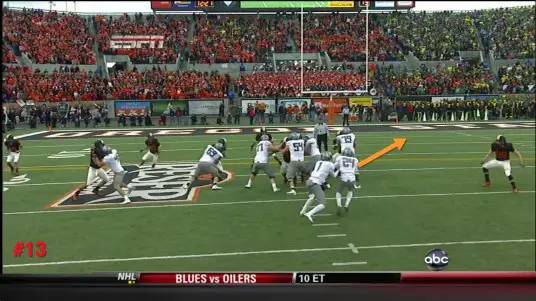
The Beaver defense has surrounded the IZR gap on the left (above) that we’re running towards, but a massive hole on the right has opened up BECAUSE we announced the play up-front, and the Beavers moved to defend the IZR. Barner started his movement toward the left, but then if you watch his footwork in the video—you see him cut toward the open gap on the right, and consequently a Touchdown! This is how you create large holes on the LOS by announcing the play in advance with your formation. The defenses have been game-planning against our Zone Read for six years now and know immediately by formation what we are doing, and Chip is counting on it since it is so difficult for any defense to stop plays along the entire LOS.
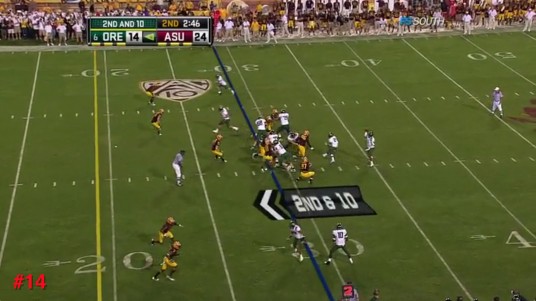
The final component that makes the Inside Zone Read work so well are all the complimentary plays, the ancillary plays that spin off the IZR formation. We may line up in an IZR formation, but then throw the bubble screen to the sideline. (above) We may run a power play to the other side of the LOS when the defense is so focused upon stopping the IZR gap. (The power play has become another bread-and-butter running play that we’ll look at in a future report) We have speed double option plays that run the other direction from where the IZR looks to be attacking. Finally we have a devastating set of play-action passes that begin with the Ducks lining up in the IZR formation and beginning to run the mesh, only to rear up and throw to a wide open WR for huge plays.
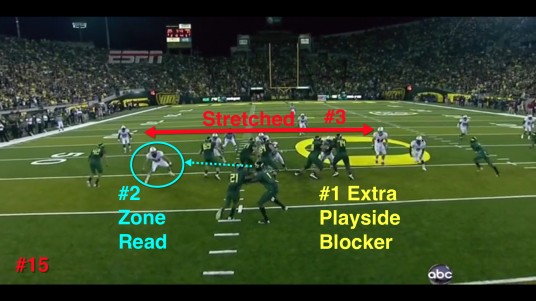
So you accomplish three things simultaneously with the Inside Zone Read, rather than simply running the tailback into the guard-tackle gap. The IZR is a dive play on the right which must be stopped by the defense, just as the Zone Read must be stopped on the left side of the LOS. First, we pick up a play side blocker which is a massive advantage, and second, by Zone-Reading the backside DL or LB, you often negate the best defensive player of another team.
Finally you stretch the defense horizontally and vertically by making the opponent defend the whole field due to all the ancillary plays that run off the same Inside Zone Read formation. All this happens by announcing an IZR in advance!
Teams Oregon plays each year not only know what we’re doing, but seeing the benefits of running the Zone Read has convinced them to begin operating it themselves. Washington has been running Zone Read plays for two years now, and their new QB will be quite skilled at it. UCLA is running Zone Read plays out of the Pistol formation, while Stanford has integrated some Zone Read into their playbook as we saw Andrew Luck run for a big gain late in the game with the Cardinal last fall.
Imagine my surprise to see Arizona State run some Zone Read against us early last season! When you add in Oregon and Utah, (who do the Zone Read superbly) we have HALF of the Pac-12 with the Zone Read in their playbook. There are no secrets here, and the difference among teams is simply the execution of the offense.
What is in the next report? We learn about the other major play that the Oregon Offense revolves around, the Outside Zone Read.
Oh how we love to learn about our beloved Ducks!
Charles Fischer (FishDuck)
Eugene, Oregon
Top Photo from FishDuck.com Video
Go to the OREGON FOOTBALL ANALYSIS LIBRARY by FishDuck.com front page to find the articles and links here.
Articles about the Oregon Spread Offense under coaches Chip Kelly, Mark Helfrich, Scott Frost, Mario Cristobal, Marcus Arroyo and Willie Taggart are present along with plays and tactics.
The Oregon Defensive Articles and Analysis are present on this page as well.
If you have an article or video link you would like to share with the Oregon Football Repository, then email me charles@fishduck.com as the writers and editors of the site are grateful for the help.
Help us Build and Maintain an Oregon Football Repository at FishDuck.com for all Duck fans!
The Oregon Football Repository is massive and contains 1,000+ Articles and Videos in 12 sections:
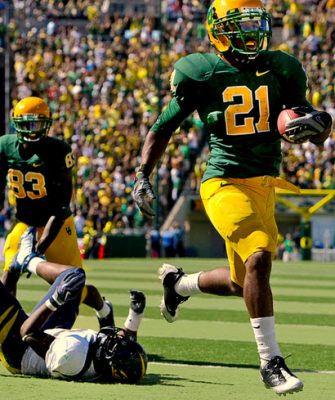
Ed Dickson and LaMichael James.
Oregon Analysis Library
ChileDuck’s Updated Football Depth Chart
Oregon Highlight Videos
Music for Ducks’ Ears
History of Oregon Football
Men of Oregon: Players and Coaches
The BEST Recruit Talent Evaluations
The BEST of “The Duck”
The BEST of FishDuck.com Humor!
Oregon’s Amazing Uniforms
Savor the “Autzen Magic”
We Love to Hate our RIVALS
Click on the live links above and enjoy!
Current articles of Analysis, Editorials, Coach’s Opinion, and Talent Evaluation will continue with new articles every week on Mondays and Wednesdays (and sometimes Fridays) at FishDuck.com as before.
Mr. FishDuck has already put tens of thousands of dollars into the site (with nothing in return) and needs help to keep these 1,000+ articles (incredible!) available, to add to them over time, and to allow him to continue to write every week. We want to keep all of this on the site free to all Oregon fans, for a very long time.
Please donate to make this site a gift to all Oregon fans as a long term source of Oregon Football Information!
Could you send a gift of $100.00 of which is eight dollars a month or a cup of coffee a week. (Two dollars a week-cheap!)
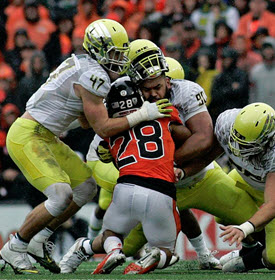
Kiko Alonso and the Oregon Defense!
Please donate to FishDuck.com at the PayPal button below under the account of charles@fishduck.com and you can also donate using your credit card by clicking on the button below. Thank you from all of us at FishDuck.com!
Want to send a check? Make it out to FishDuck.com and send to:
FishDuck.com, Charles Fischer
1500 Valley River Dr. Ste 315
Eugene, OR 97401
Our entire staff thanks you!

